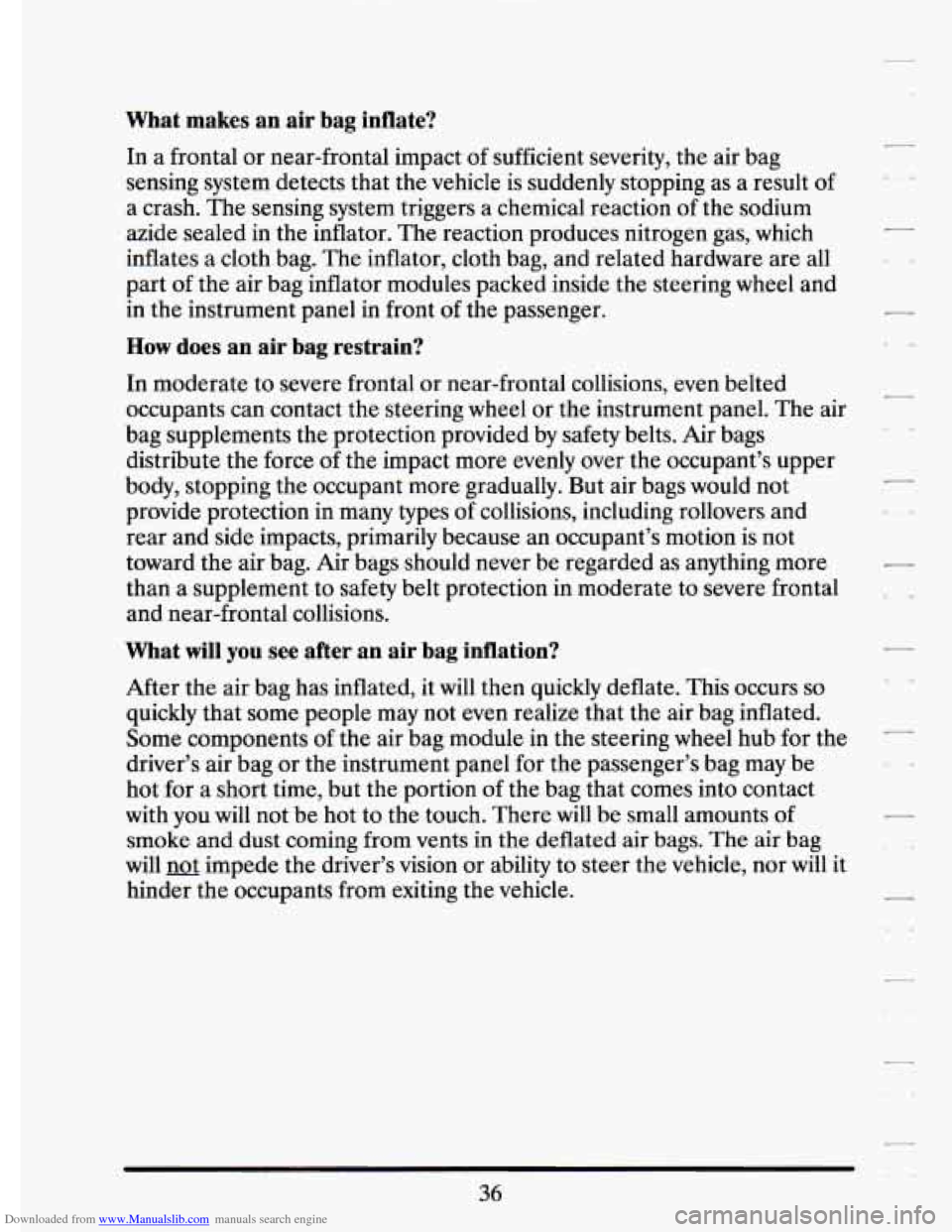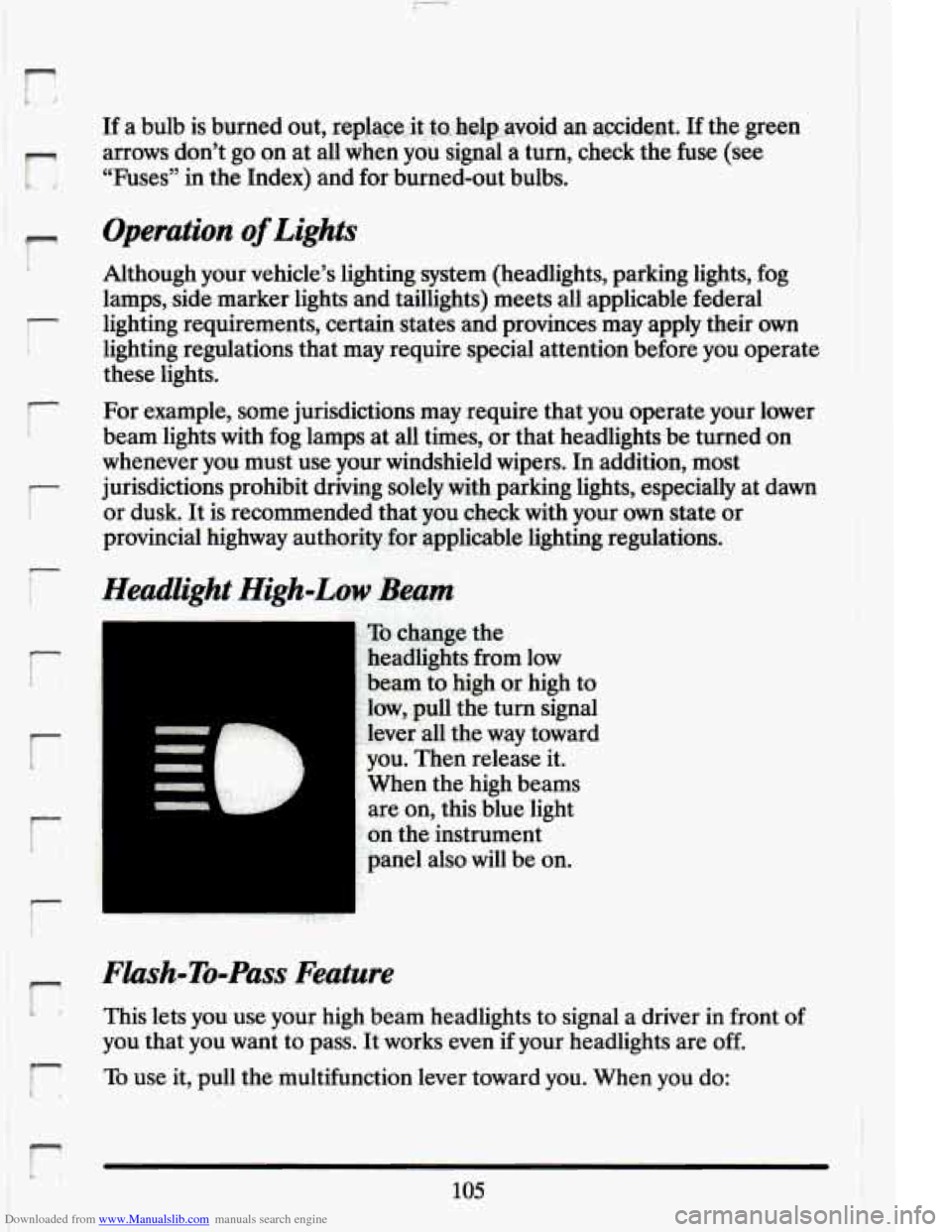Page 30 of 398
Downloaded from www.Manualslib.com manuals search engine I
or the instrument
panel
...
or the safety belts!
With safety belts, you
slow down as the vehicle does. You get more time
to stop. You stop over more distance, and your strongest bones take the
forces. That's why safety belts make such
good sense.
7
18
-*
Page 44 of 398
Downloaded from www.Manualslib.com manuals search engine Air Bag Readiness Light
There is an air bag readiness light on the instrument panel, which has the
system checks for electrical malfunctions, and the light tells you if there
is -
a problem.
AIR
BAG AIR BAG
You will see the “AIR
BAG” light flash for
a few seconds when
you turn your ignition
to “Run” or “Start.”
Then the light should
go out, which means
the system is ready.
32
Page 46 of 398
Downloaded from www.Manualslib.com manuals search engine Where is the air bag?
The driver’s air bag is in the middle of the steering wheel. The right-front
passenger’s air bag
is located in the instrument panel on the passenger’s
side.
Page 48 of 398

Downloaded from www.Manualslib.com manuals search engine What makes an air bag inflate?
In a frontal or near-frontal impact of sufficient severity, the air bag
sensing system detects that the vehicle is suddenly stopping as\
a result of
a crash. The sensing system triggers a chemical reaction of the sodium
azide sealed
in the inflator. The reaction produces nitrogen gas, which
inflates a cloth bag. The inflator, cloth bag, and related hardware are all
part
of the air bag inflator modules packed inside the steering wheel and
in the instrument panel in front of the passenger.
How does an air bag restrain?
In moderate to severe frontal or near-frontal collisions, even belted
occupants can contact the steering wheel or the instrument panel. The air
bag supplements the protection provided by safety belts. Air bags
distribute the force of the impact more evenly over the occupant’s upper
body, stopping the occupant more gradually. But air bags would not
provide protection in many types
of collisions, including rollovers and
rear and side impacts, primarily because an occupant’s motion is \
not
toward the air bag. Air bags should never be regarded as anything more
than a supplement to safety belt protection
in moderate to severe frontal
and near-frontal collisions.
What will you see after an air bag inflation?
After the air bag has inflated, it will then quickly deflate. This occur\
s so
quickly that some people may not even realize that the air bag inflated.
Some components of the air bag module
in the steering wheel hub for the
driver’s air bag or the instrument panel for the passenger’s bag may be
hot for a short time, but the portion of the bag that comes into contact
with you will not be hot to the touch. There will be small amounts of
smoke and dust coming from vents in the
deflated air bags. The air bag
will
not impede the driver’s vision or ability to steer the vehicle, nor will it
hinder the occupants from exiting the vehicle.
36
Page 78 of 398
Downloaded from www.Manualslib.com manuals search engine FEATURES AND CONTROLS
Here you can learn about the many standard and optional features on
your Cadillac, and information on starting, shifting and braking\
.
Also
explained are the instrument panel and the warning systems that tell you
if everything is working properly
-- and what to do if you have a problem.
KEYS
66
c9
---
Page 116 of 398
Downloaded from www.Manualslib.com manuals search engine Turn Signal and Lane Change Indicator
A green arrow on the
instrument panel
will
flash in the direction of
the turn or lane
change.
To signal a lane change, just raise or lower the lever until the green arrow
starts to flash. Hold it there until you complete your lane change. The
lever
will return by itself when you release it.
If for some reason, your turn signal is left on; the Driver Information
Center will display
"TURN SIGNAL ON" (after driving about a mile) to
remind you to turn it
off.
As you signal a turn or a lane change, if the arrows don't flash but just
stay
on, a signal bulb may be burned out and other drivers won't see your ~
turn signal.
104
Page 117 of 398

Downloaded from www.Manualslib.com manuals search engine r
r
!-
r
r
lr
If a bulb is burned out, ~~p~a~~~,~~.~~~.h~~~~a~~~~-an ,?wide$. If the green
arrows don’t
go on at all when you signal-a turn, check the fuse (see
“Fuses” in the Index) and for burned-out bulbs.
Operation of Lights
Although your vehicle’s lighting system (headlights, parking \
lights, fog
lamps, side marker lights and taillights) meets all applicable federal
lighting requirements, certain states and provinces may apply their
own
lighting regulations that may require special attention before you operate
these lights.
For example, some jurisdictions may require that you operate your lower
beam lights with fog lamps at all times, or that headlights be turned on
whenever you must use your windshield wipers. In addition, most
jurisdictions prohibit driving solely with parking lights, especially at dawn
or dusk. It is recommended that you check with your
own state or
provincial highway authoritfi for applicable lighting regulations.
Headlight High-Low Beam
To change the
headlights from low
‘beam to high or high to
low,
pull the turn signal
lever all the way toward
you. Then release it.
When the high beams
are on, this blue light
on the instrument
panel also will be on.
Flash-To-Pass Feature
This lets you use your high beam headlights to signal a driver in front of
you that you want to pass. It works even if your headlights are off.
To use it, pull the multifunction lever toward you. When you do:
105
Page 122 of 398
Downloaded from www.Manualslib.com manuals search engine CAUTION
.. .. , ...
Hyeu lteave yuur Cruise Control switch on,when you’re not
using Cruise, you might hit a button and go into Cruise when
you don’t
want to. You could be startled and even lose control.
Keep the Cruise Control switch tCOFI?n until you want to use it.
2. Get up to the speed you want.
4. The digital
instrument panel
cluster has a
“CRUISE
ENGAGED” light
CRUISE ENGAGED that will come on.
On the analog cluster the “CRUISE ENGAGED” message will
display
for a few seconds.